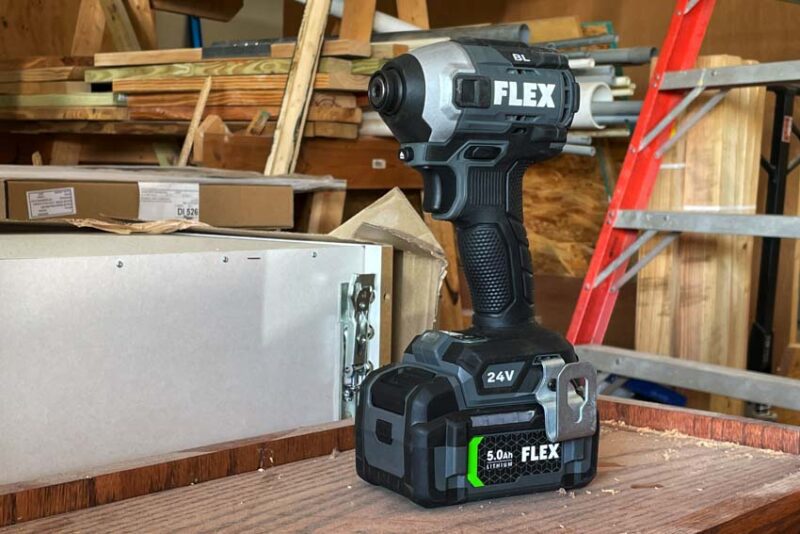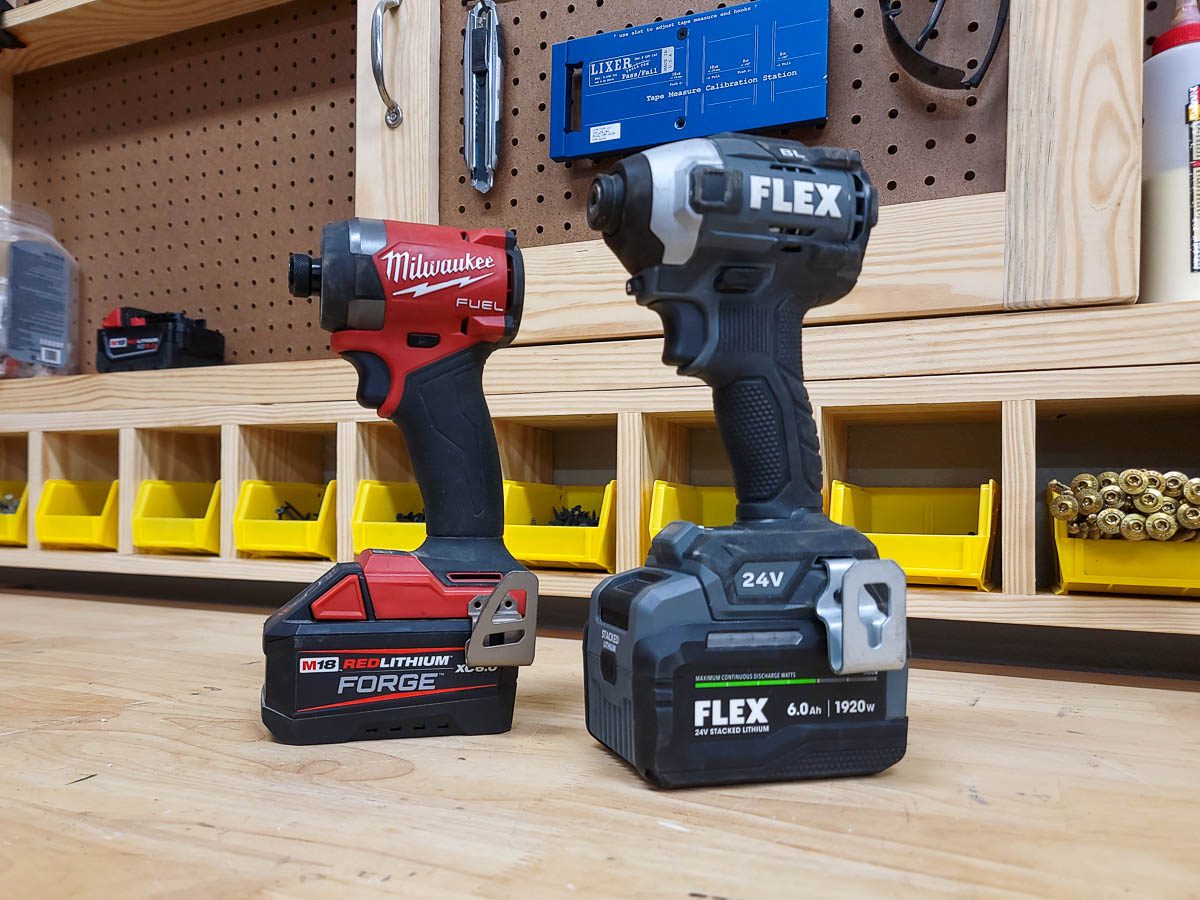Over the years, we’ve had the opportunity to test some of the best impact drivers on the market, and today we want to compare two top-performing models—the Flex 24V FX1381 and the Milwaukee M18 Fuel 2953. Both models are feature-rich, powerful, and designed for the Pro market. So, which one is going to reign supreme? Let’s find out!
Flex vs Milwaukee Impact Driver Specifications
Here’s a quick look at the key specs to know before we jump into testing:
| Flex FX1371 | Milwaukee 2953 | |
|---|---|---|
| Top Speed | 1900/2700/4000 | 1700/3000/3900 |
| Max Impact Rate | 4450 IPM | 4400 IPM |
| Max Torque | 2500 in-lbs | 2000 in-lbs |
| Head Length | 4.8 in. | 4.5 in. |
| Bare Weight | 2.8 lbs | 2.2 lbs |
| Working Weight | 5.05 lbs (with 6.0Ah Stacked Lithium battery) | 4.28 lbs (with 6.0Ah Forge battery) |
Flex vs Milwaukee Impact Driver Tests Explained

Let’s start by setting the stage by talking about our battery selection. To get the best results, we decided to pair these tools with their respective advanced battery packs—Flex with a 24V Stacked Lithium 6.0Ah battery, and Milwaukee with an M18 Forge 6.0Ah battery.
Speed Test with Ledger Screws
To kick off our testing, we started by driving three 8-inch GRK Fasteners RSS screws into our stacked OSB test block. Our result is the average time it takes for each tool to drive the screws fully. This is a medium-load test, and well within the scope of these tools.
Breakaway Test
Next, we torqued eight 1 1/2-inch Grade-8 hardened steel nuts to 150 ft-lbs (1,800 in-lbs) and timed how long it takes each tool to loosen them. The result is the total time added together for all eight bolts.
Concrete Drilling Test
While drilling in concrete is typically reserved for a hammer drill, an impact driver can certainly get the job done, just not as fast. For our test, we drilled three 3-inch holes in our 4000 PSI concrete test block with a 3/8-inch masonry bit and averaged the times.
Lag Bolt Speed Test
For our last test, we kicked up the intensity with one more driving test. We returned to our OSB test block and drove three 8×3/8-inch lag bolts and averaged the times to get our results.
Testing Results
| Flex FX1371 | Milwaukee 2953 | |
|---|---|---|
| RSS Screw Average | 6.70 sec | 5.90 sec |
| Bolt Break Total | 4.08 sec | 3.02 sec |
| Concrete Drilling Average | 5.77 sec | 7.74 sec |
| Lag Bolt Test Average | 5.07 sec | 5.80 sec |
As you can see from our results, these tools are pretty evenly matched. Looking at the specs, there are some clear differences in both speed and torque, but the results speak for themselves.
Flex VS Milwaukee Impact Driver Key Highlights
Flex FX1371

- Brushless motor
- 3 standard modes
- 2 assist modes
- Quick Eject button above the trigger
- Foot-mounted LED light
MIlwaukee 2953

- Brushless motor
- 3 standard modes
- 1 assist mode
- One-hand bit insertion
- 3 LED lights around the collet
- Available with One-Key smart controls and tracking (model 2957)
Pricing and Final Thoughts
| Flex FX1371 | Milwaukee 2953 | |
|---|---|---|
| Bare Tool | $159 | $149 |
| Kit #1 | $249 1 x 2.5Ah Battery 1 x 5.0Ah Battery Fast Charger | $299 2 x 5.0Ah batteries Charger |
| Kit #2 | $279 6.0Ah Stacked Lithium Battery Fast Charger | N/A |
| Combo Kit #1 | $349 Impact Driver Hammer Drill 1 x 2.5Ah battery 1 x 5.0Ah battery Fast Charger | $399 Impact Driver Hammer Drill 2 x 5.0Ah batteries Charger |
| Combo Kit #2 | $499 Impact Driver Hammer Drill 1 x 3.5Ah Stacked Lithium battery 1 x 6.0Ah Stacked Lithium battery Fast Charger | N/A |
| Warranty | Lifetime w/ Registration (5 years standard) | 5 years |
When it comes right down to it, these tools truly are very evenly matched in terms of power and capacity. Admittedly, Flex is a bit heavier than Milwaukee, but beyond that, there really aren’t any major differences on the performance side.
For me, I genuinely feel like this decision comes down to personal preference, but if it were up to me I’d go with Flex because there is a wider variety of kit/battery options. However, if you’re already on the M18 battery platform, I’d have to recommend you stay there and choose the 2953, and the same sentiment goes for Flex users. Either way, you’re getting a great tool, so you really can’t go wrong!



